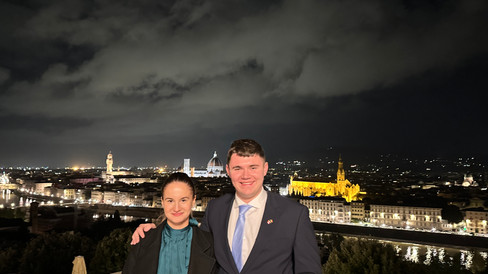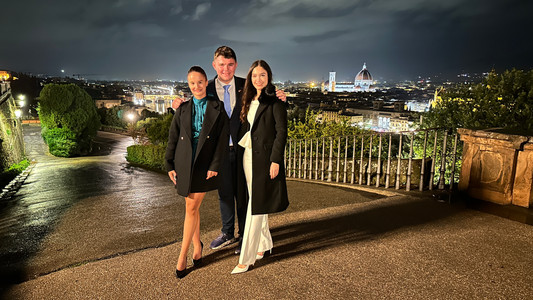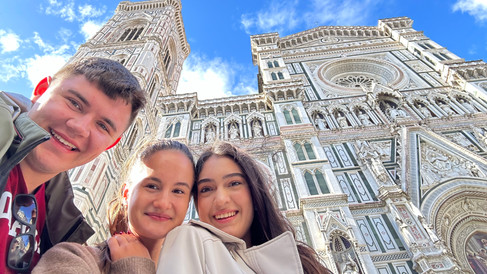Under the Tuscan Sky
- Philip Ioan Zaharie
- Nov 12, 2023
- 8 min read
Florence (November 1 - 4, 2023)
San Marino (November 2, 2023)
San Gimignano (November 3, 2023)
Siena (November 3, 2023)
Pisa (November 3, 2023)
Globetrotters: Philip Zaharie, Ariana Mîndru, Briana Paraschiv

1st November 2023 - TIMIȘOARA - FLORENCE
Our journey commenced with the excitement of new discoveries as we boarded flight LH1659 from Timișoara to Munich. After a brief transit in Munich, we were airborne again on flight EN8198, heading towards the enchanting city of Florence. Florence, with its rich history as the cradle of the Renaissance, awaited our eager exploration.
Upon arrival, the city greeted us with its distinctive architectural beauty, where every building and street seemed to hold a story. The night lent Florence a magical quality, with the soft illumination of its historic buildings and streets creating a captivating ambiance.
Our accommodation at La Torre del Cestello - Residenza d'epoca was a perfect reflection of this ambiance. This historical residence, set in a building that harkened back to the Renaissance era, offered a luxurious and authentic Florentine experience. The apartment, with its elegant decor and historical charm, was a harmonious continuation of our journey through time.
Exploring Florence by night was an awe-inspiring experience. The city, illuminated in a gentle glow, revealed its treasures in a more intimate setting. The iconic Ponte Vecchio over the Arno River, the majestic Duomo standing tall against the night sky, and the quiet, art-laden streets all combined to create an unforgettable first night in this city of art and history.
2nd November 2023 - A Day of Historic Exploration
Our second day in Italy unfolded with an early departure from Florence, a city where the Renaissance left an indelible mark on every street and piazza. We left behind the art-filled alleys and stunning architecture of Florence, embarking on a road trip to one of Europe's most intriguing microstates - San Marino.
The drive from Florence to San Marino, covering about 250 kilometers, was a journey through diverse Italian landscapes, each echoing a different part of the country's rich history. As we meandered through the Tuscan countryside, the scenery reminded us of the area's deep historical roots, stretching back to Etruscan times and flourishing during the Renaissance. The rolling hills and vineyards outside our windows were more than just picturesque scenery; they were lands that had witnessed the rise and fall of powerful families like the Medicis and the march of armies during Italy's unification.
San Marino: A Sovereign Relic
Arriving in San Marino, a landlocked sovereign state nestled on Mount Titano, was like stepping into a medieval world. Founded in 301 AD by Saint Marinus, a stonemason seeking refuge from religious persecution, San Marino prides itself on being one of the world's oldest republics. This sense of historical continuity is palpable as you walk its ancient streets.
The city’s architecture is a living museum of its storied past. We visited the Three Towers of San Marino, located on the peaks of Mount Titano. These fortresses, dating back to the 11th century, have served as defensive strongholds throughout the republic's history. The oldest, Guaita, was constructed in the 11th century and has been a silent witness to San Marino’s enduring independence, even as surrounding territories fell to foreign powers.
The Palazzo Pubblico, San Marino's town hall and government building, is an exemplary piece of medieval architecture. Its façade, adorned with coats of arms and a clock tower, overlooks the Piazza della Libertà, a testament to the republic's long-standing dedication to freedom and self-governance.
Return to Florence: Reflecting on the Day
Our return drive to Florence in the late afternoon was a time to reflect on the stark contrast between the bustling Renaissance city and the tranquil medieval streets of San Marino. The landscapes seemed to narrate Italy's complex history as we drove back through the Tuscan countryside, where every hilltop and valley had a story to tell.
The day culminated with an exquisite dinner at La Buchetta Food & Wine Restaurant in Florence. Renowned for its blend of traditional Tuscan cuisine and innovative culinary approaches, the restaurant provided a perfect setting to unwind. Our highlight was the Fiorentina steak, a Tuscan specialty known for its rich flavor and succulent texture. Savoring this delicacy, crafted from locally sourced ingredients, we reminisced about our day's journey through time, from the bustling streets of Florence to the serene, historic paths of San Marino.
Our second day in Italy was more than a sightseeing trip; it was a voyage through time. From the Renaissance splendors of Florence to the medieval walls of San Marino, we traversed centuries of history, gaining a deeper appreciation for the region's rich cultural tapestry. As we rested that night, the day's experiences swirled in our minds, a blend of art, history, and the enduring spirit of Italy.
3rd November 2023 - Florence, San Gimignano, Siena, and Pisa
Our day began with a departure from Florence. Heading towards San Gimignano, we traversed the Tuscan landscape, a region that has been the backdrop of history, art, and culture for centuries.
San Gimignano: The Town of Fine Towers
Emerging through the Tuscan fog, San Gimignano presented itself like a scene from a medieval tapestry. Known as the 'Town of Fine Towers', San Gimignano's history is as fascinating as its skyline. Established by the Etruscans in the 3rd century BC, it flourished in the Middle Ages due to its location on the Via Francigena, the pilgrimage route to Rome. The town's prosperity in the 12th and 13th centuries led to the construction of numerous towers, built by wealthy families to display their economic and political power. Originally boasting 72 towers, only 14 remain today, but they still dominate the town's skyline, offering a glimpse into its affluent past. The rain, while hindering our exploration, lent an air of mystique to the ancient stone buildings and cobbled streets, imbuing them with a sense of enduring timelessness.
Siena: A Gothic Masterpiece
The drive to Siena was a journey from one historical treasure to another. As we entered Siena, we were enveloped in its rich history. The city, famous for its Gothic architecture, is a living museum. The Siena Cathedral (Duomo di Siena), commenced in the 12th century, is a pinnacle of Gothic architecture. Its elaborate façade, adorned with intricate sculptures and mosaics, and the unique black and white marble stripes symbolize the city's artistic heritage. Siena’s historical significance extends beyond its cathedral. The city’s fan-shaped central square, Piazza del Campo, is renowned for hosting the Palio horse race, a tradition that dates back to medieval times and embodies the city’s communal spirit and competitive history. This square, with its shell shape, is surrounded by various historical buildings, including the Palazzo Pubblico with its imposing Torre del Mangia. Walking through the streets of Siena, we were captivated by the well-preserved medieval cityscape, which allowed us to envision life in a thriving 13th-century Tuscan city.
Evening: Culinary Excellence at Enoteca Pinchiorri in Florence
Returning to Florence, we prepared for an evening at Enoteca Pinchiorri. This restaurant, a jewel in Florence’s culinary crown, holds three Michelin stars and is situated in a Renaissance palace. Dining at Enoteca Pinchiorri was not just a meal; it was an experience that blended the rich traditions of Tuscan cuisine with contemporary gastronomy. Each dish was a testament to the chef’s mastery, showcasing local ingredients and innovative techniques.
Night: Piazalle Michelangelo and the Leaning Tower of Pisa
Our visit to Piazalle Michelangelo offered a panoramic view of Florence, a city where every corner is steeped in art and history. The view from this vantage point at night, with the city lights reflecting off the Arno River, was nothing short of magical.
The night took us further to Pisa, where we stood in awe of the Leaning Tower. This bell tower, part of the cathedral complex, is famous worldwide for its unintended tilt. Construction of the tower began in 1173 and took nearly 200 years to complete. The tilt, due to the soft ground, started during its construction and progressively worsened until restoration efforts stabilized it in the late 20th and early 21st centuries. The Leaning Tower of Pisa is not only an architectural wonder but also a symbol of human ingenuity and persistence.
Our return to Florence after midnight marked the end of a day rich in history and cultural experiences.
4th November 2023 - Florence's Artistic Wonders
The morning in Florence was an intimate encounter with the Renaissance. The Uffizi Museum, a cornerstone of art history, was our first destination. Originally designed by Giorgio Vasari in the 16th century as offices for the Florentine magistrates, it transformed into a gallery under the Medici family, showcasing their extensive art collection. The museum's corridors and rooms are lined with works that changed the course of art history, from Botticelli’s ‘Primavera’ to Caravaggio's ‘Medusa’.
After leaving the Uffizi Museum, we wandered through the winding streets of Florence's historic heart, making our way to the iconic Ponte Vecchio. This medieval stone bridge, with its shops built upon its edges, is a testament to Florence's enduring charm. Historically home to goldsmiths and jewelers, the bridge's bustling commerce and picturesque views over the Arno River offered a brief interlude filled with the essence of Florentine life
Our stroll through the historic center of Florence brought us also to the Accademia Gallery, home to Michelangelo's David. Although we couldn’t secure tickets, the history of David remains fascinating. Created between 1501 and 1504, this masterpiece is renowned not just for its size and beauty, but for its representation of Renaissance ideals. Michelangelo carved David from a single block of Carrara marble, and it originally stood in the Piazza della Signoria as a symbol of Florentine freedom and defiance against larger rival states.
After our attempt to visit Michelangelo's David at the Accademia Gallery, we ventured towards the historic heart of Florence's civic life, the Palazzo Vecchio. This imposing fortress-palace serves as the city hall and stands as a symbol of the civic pride and political history of Florence. With its crenellated battlements and the towering form of Arnolfo's Tower, the Palazzo Vecchio dominates the Piazza della Signoria, offering a glimpse into the rich tapestry of Florence's past. Originally built in the early 14th century as the seat of the Republic of Florence's government, it has witnessed the city's transformation through the Renaissance and beyond. Its halls and chambers, adorned with lavish artworks and frescoes, tell the stories of the city's powerful leaders, including the Medici family, who were instrumental in shaping Florence into a cradle of the Renaissance
Nearby, the Cattedrale di Santa Maria del Fiore, known simply as the Duomo, dominates the cityscape. Its most striking feature is the massive dome, engineered by Filippo Brunelleschi. Completed in 1436, the dome was a feat of engineering, constructed without the support of scaffolding, and remains the largest brick dome ever constructed. The cathedral itself, begun in 1296, is a masterpiece of Gothic architecture, with its intricate marble façade reflecting Florence's wealth and artistic prowess during the Renaissance.
Leaving the artistic splendors of Florence, we boarded our flight to Munich and then to Timișoara.
Our next flight from Munich took us to Timisoara, a city with a vibrant and diverse past. As the plane descended, we anticipated exploring this city known for its role in the Romanian Revolution of 1989, which led to the overthrow of Communism in Romania. Timisoara, with its architectural styles ranging from Baroque to Art Nouveau, reflects its history under Turkish, Austrian, and Hungarian rule.
Our journey from the Renaissance wonders of Florence to the medieval charm of San Gimignano and Siena was a captivating immersion into Italy’s rich heritage. Each city, with its unique historical tapestry, from the artistic majesty of the Uffizi Gallery to the architectural splendor of the Tuscan countryside, enriched our understanding and love for Italy’s diverse cultural landscape. This voyage was not just a trip through places, but a timeless journey through history, art, and culinary excellence.






















































Comments